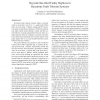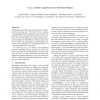NSDI
2007
14 years 1 months ago
2007
Despite many efforts, the predominant practice of debugging a distributed system is still printf-based log mining, which is both tedious and error-prone. In this paper, we present...
NSDI
2007
14 years 1 months ago
2007
Byzantine fault tolerant systems behave correctly when no more than f out of 3f + 1 replicas fail. When there are more than f failures, traditional BFT protocols make no guarantee...
NSDI
2007
14 years 1 months ago
2007
Network coordinates provide a mechanism for selecting and placing servers efficiently in a large distributed system. This approach works well as long as the coordinates continue ...
NSDI
2007
14 years 1 months ago
2007
Many studies show that, when Internet links go up or down, the dynamics of BGP may cause several minutes of packet loss. The loss occurs even when multiple paths between the sende...
NSDI
2007
14 years 1 months ago
2007
This paper proposes a new approach to anonymous communication called information slicing. Typically, anonymizers use onion routing, where a message is encrypted in layers with the...
NSDI
2007
14 years 1 months ago
2007
The lack of an accurate representation of the Internet topology at the Autonomous System (AS) level is a limiting factor in the design, simulation, and modeling efforts in inter-d...
NSDI
2007
14 years 1 months ago
2007
Debugging and profiling large-scale distributed applications is a daunting task. We present Friday, a system for debugging distributed applications that combines deterministic re...
NSDI
2007
14 years 1 months ago
2007
Modern Internet systems often combine different applications (e.g., DNS, web, and database), span different administrative domains, and function in the context of network mechanis...
NSDI
2007
14 years 1 months ago
2007
The network and distributed systems research communities have an increasing need for “replayable” research, but our current experimentation resources fall short of reaching th...
NSDI
2007
14 years 1 months ago
2007
: The physical locations of clients and access points in a wireless LAN may have a large impact on network performance. However, today’s WLAN management tools do not provide info...



